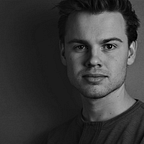Testing: Tilt brush
“Tilt Brush lets you paint in 3D space with virtual reality. Your room is your canvas. Your palette is your imagination. The possibilities are endless.” That’s what google says about it. I gave it a try.
The tool
Tilt brush is a VR sketching tool, created by Google. The tool lets you paint in three dimensions with tools like a brush, pen, and effect brushes like stars, lights, fire and rainbows. It has some environment presets, to change the scene your’e in, as well as an option to adjust the light direction in your scene. It also has a neat scale tool, letting you scale your drawing from “a squirrel to an elephant” point of view.
Impressions
Tilt brush is my first experience with VR sketching in general. The tool is quite straight forward — you start in an empty environment where you can draw around you with a paint brush.
My initial thought was that Tilt brush felt like a sketch book in VR, with an empty canvas and a simple set of tools. But after a few minutes familiarising with the interface and playing around with the different tools available, it feels more like a colouring book with fancy brushes and stickers.
The good part of having a limited set of tools and functions, is that it is quite easy to start drawing straight away. Select tool- Draw- Erase- Draw- Scale- Draw more. At the same time it feels like the tool is created for those who want to create a fantasy scenery or concept art, not sketches of product concepts. The main reason why I think so, is because the set of brushes included is quite focused on effects like sparkles, fire, blinking lights.
An other reason is the limited tools to either guide you (like rulers) when you draw or to edit an existing line. Drawing in VR is difficult in its nature, in terms of not having any resistance in the medium. The paper is a resistance in a sketch, as clay is in a sculpture, but in VR your hands does not meet any friction. This results in low accuracy, and the need for editing tools becomes visible quite quickly.
A really fun and useful feature is the scaling tool. This makes you able to draw a little sketch of a house, then scale it up and walk inside it. I do think that this is a really powerful part of sketching in VR, and one of the main benefits of using VR sketching as a tool when creating large objects and spaces.
Lesson learned
Notes and thoughts from the test, relevant for the documentation of using VR as a design tool.
Three axes is one axis too much
This was my first meeting with a sketching tool in 3D space — Not 2D as I am used to. The first thing I noticed was how hard it was to continue on a line, or make two endpoints meet. A normal sketch technique practice is to draw multiple lines on top of each other, and make it look as a singular line. That is of course even harder in a VR sketch, because of the extra axis. I assume this just takes some practice, but it is worth a thought.
A straight line is not straight
An other thing I experienced quite quickly is that when I tried to draw a straight line in front of me it warped around me (viewed from the top-plane) because of the arm movement. This may sound obvious, but it became really visible when my first sketches looked like they was wrapped onto a sphere.
Potential
Tilt brush has some potential in its simplicity. The limited set of opportunities and edit-tools means less tools to get lost into and makes it to the point.
Texture brushes
Meanwhile the brushes in Tilt brush are more fun than practical, I do see a potential in texture brushes. Being able to draw in a specific material could be really useful, as well as creating brushes from patterns like vents, button racks, railings and other patterns.
Final thoughts
Tilt brush feels like a fantasy world-creator, more than a sketch book to start designing new ideas for real-life concepts. With a majority of tools like fire textures, light effects and leafs, I see Tilt brush as a good introduction to VR sketching where you can draw a dream scene, rather than a professional tool.
Again — this is not only my first meeting with Tilt brush, but also with VR sketching in general. Therefore it is hard to separate what it part of my impression of the tool itself and impressions of VR sketching in general.
Pros
- Easy to start drawing
- Multiple brushes and tools to play around with
- Easy to document sketches with snapshots and gifs
- Easy to operate, draw and view in different scales
Cons
- Hard to navigate and teleport around in the scene
- Few useful brushes — from a designers perspective
- Low accuracy
- Little options to edit a sketch, and few tools like “rulers” or guides
